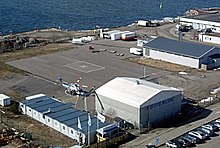


A heliport, sometimes termed a vertiport, is a small airport suitable for use by helicopters and various types of vertical lift aircraft. Designated heliports typically contain one or more touchdown and liftoff areas and may also have limited facilities such as fuel or hangars. In some larger towns and cities, customs facilities may also be available.[1]
Early advocates of helicopters hoped that heliports would become widespread, but they have become contentious in urban areas due to the excessive noise caused by helicopter traffic.
In American use a heliport is defined as "an area of land, water, or structure used or intended to be used for the landing and takeoff of helicopters and includes its buildings and facilities if any". A heliport will consist of one or more helipads, which are defined as "a small, designated area, usually with a prepared surface, on a heliport, airport, landing/take-off area, apron/ramp, or movement area used for takeoff, landing, or parking of helicopters".[2][3]
In Canada the term heliport is legally only used for a certified aerodrome for helicopter use.[4]
- ^ Transport Canada (25 September 2015). "Standard 325 - Heliports - Canadian Aviation Regulations (CARs)". tc.canada.ca. Archived from the original on 30 April 2022. Retrieved 30 April 2022.
- ^ Federal Aviation Administration (17 June 2021). "Aeronautical Information Manual" (PDF). faa.gov. Retrieved 29 April 2022.
- ^ Federal Aviation Administration (29 March 1962). "PART 1 - Definitions and Abbreviations". Federal Aviation Regulations. Retrieved 29 April 2022.
- ^ Transport Canada (28 April 2022). "Canadian Aviation Regulations SOR/96-433". lois-laws.justice.gc.ca. Retrieved 29 April 2022.
heliport means an aerodrome in respect of which a heliport certificate issued under Subpart 5 of Part III is in force